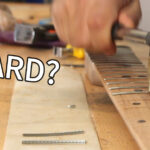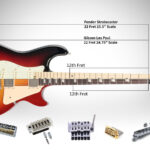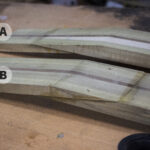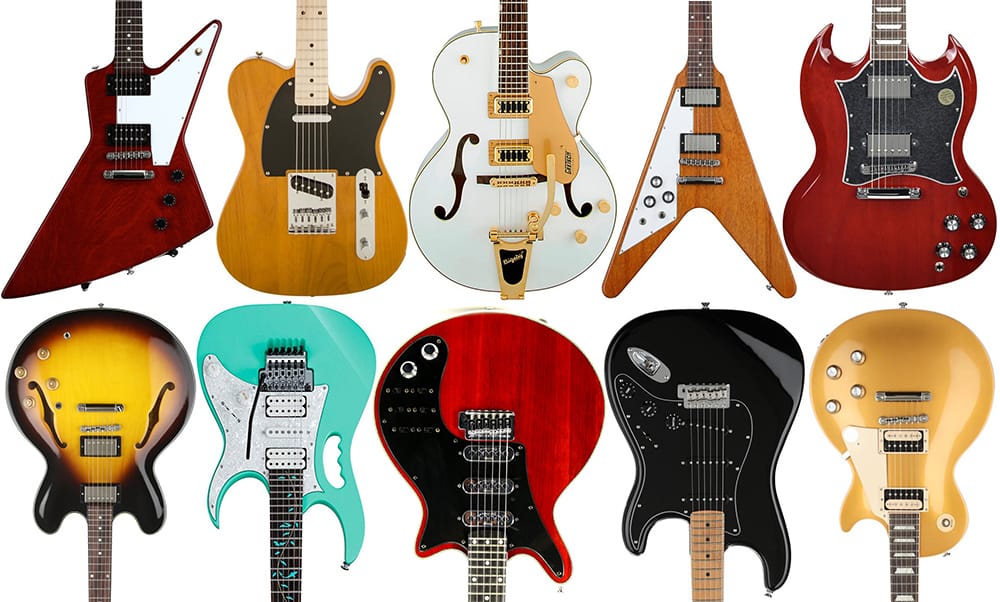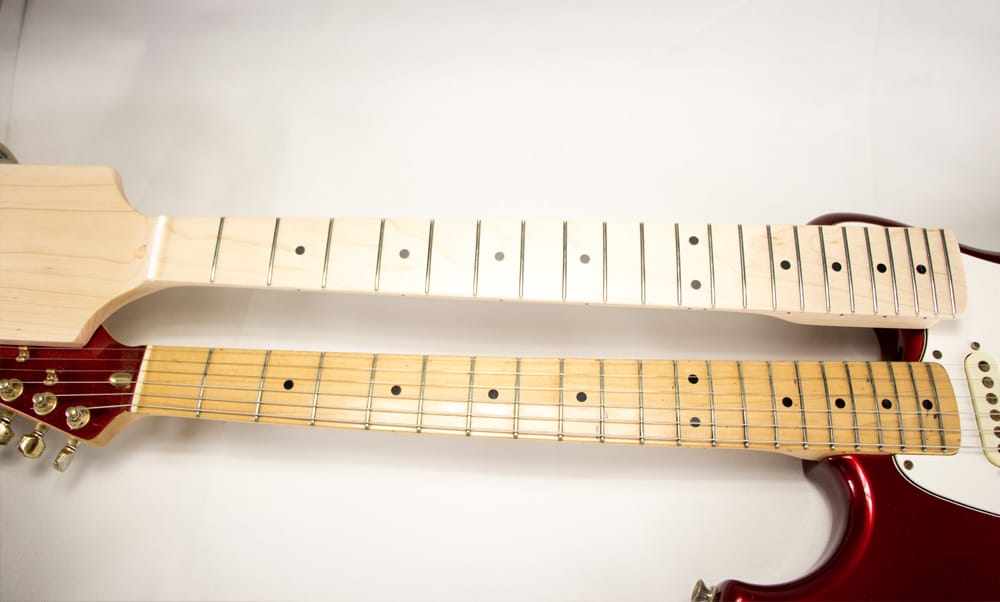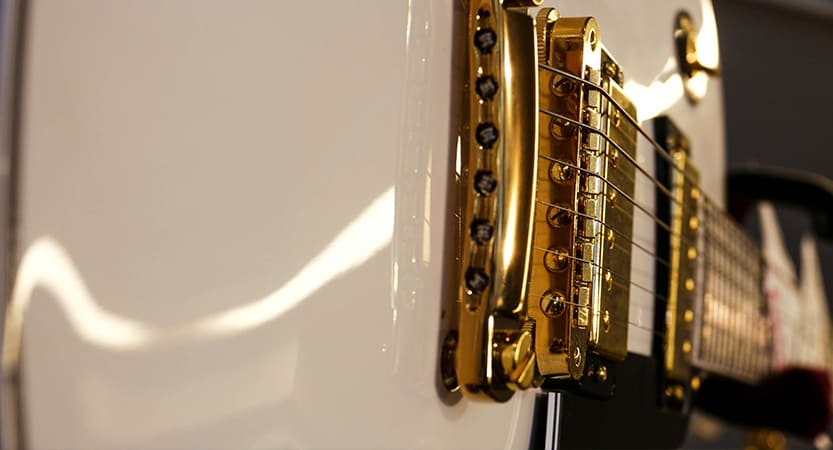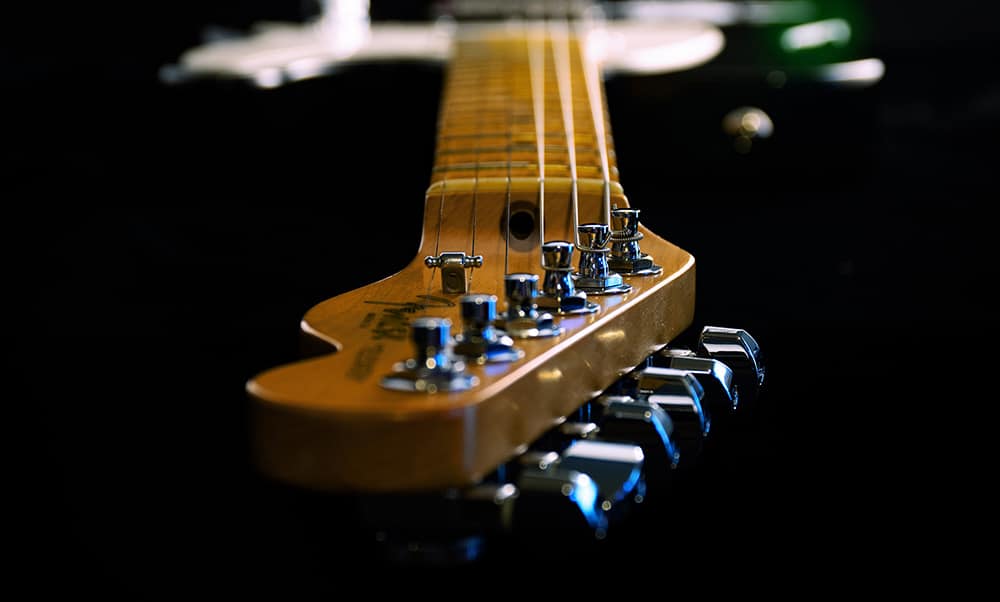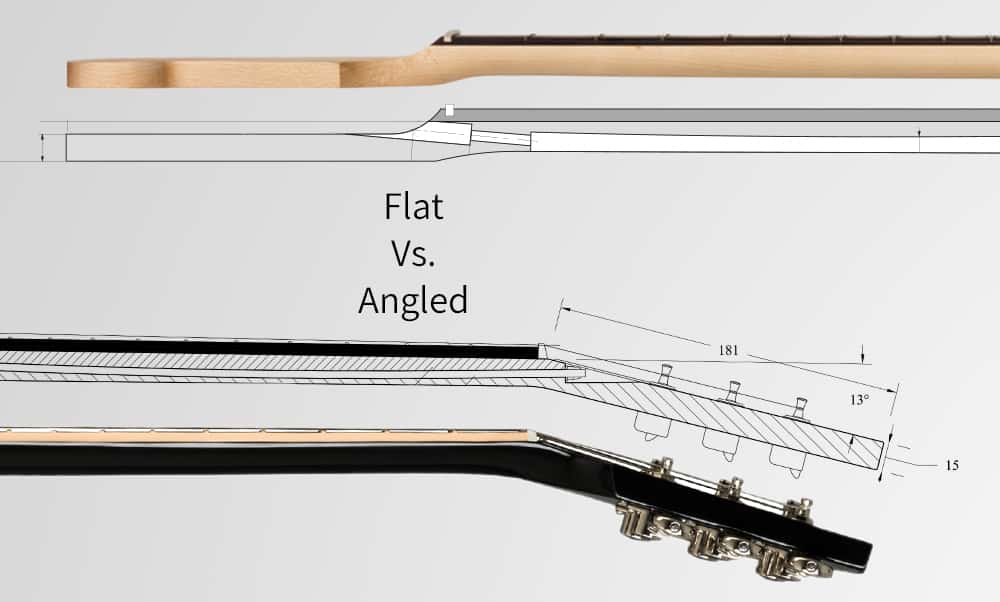If you are thinking of buying or building an electric guitar one of the most dominant visual considerations is the body. There many different types of bodies. They differ in the overall shape, the style, they remind you of certain music icons, a type of music or a time in your life. The choice is esthetical for sure, but is also sentimental and practical.
Let’s understand electric guitars styles and shapes
The main groups of electric guitar bodies can be divided into three:
· Hollow Body Instruments
· Semi Hollow Body
· Solid Body Instruments
The shape and design of electric guitars developed and evolved in the last hundred years and today you can choose which you would fit your preferred style of music, fashion or guitar icon.
With all these different shapes and styles one can get a bit confusing. Whether you are planning on buying or building your next guitar we’ll try and sort things out to get a clear view of what these guitars are all about.
How did these styles develop?
The first electric guitar was the Rickenbacker ‘Frying Pan’ from 1931. Despite the technological achievement, as the name suggests, the minimal flat circular body, wasn’t much in style department. It did though show that electric guitars did not necessarily need to follow the traditional shape of classic Spanish guitars and acoustic guitars as they relied more on their pickups than acoustics. The Gibson ES-150 from 1936 was more of a traditional shaped guitar which was followed by their ES-175 in 1949 which followed similar lines but introduced a cutaway which will become prominent with most electric guitars. The real revolution in style and shapes started in the 50s when Fender introduced the solid body Telecaster and then the Stratocaster. Gibson followed with their Les-Paul and a little later the SG model. Although most manufacturers still make guitars that that follow or stay in the general shapes of these makers, guitar shapes have been something open to interpretations.
Does an Electric Guitar’s Shape Affect the Sound?
There are many factors that determines what a guitar sounds like. The size, weight, type of wood, scale length, pickups, other mechanics and of course the shape. The most obvious factor is the acoustic aspect. Generally speaking, the more acoustic properties a guitar will have the warmer and fuller the sound will potentially be. On the other end of the tone scale will be very clear and clean sound with ‘chimy’ and metallic properties. This will be felt more with a smaller body made from very hard or dense material. It is hard to separate one factor from another but the general rule of thumb will dictate that the more material and chambers a body has, the more it will tend to give a warm sound and if you eliminate air and material you will be clear and twiny.
Hollow Body Guitars
Taking the basic traditional shape of classic Spanish guitars and adapting to electric was maybe the obvious choice, but till this day is a favorite of many artists. These guitars are characterized by staying truly and fully hollow and add a lot of warmth and depth to the clearer metallic sound of the pickup. The acoustic sound that accompanies and mixes with the electric pickup lends itself well mostly to Jazz and blues and have even been used by the Beatles. The main drawback of the Hollow Body Electric Guitars is their tendency to create a lot of feedback when amplified.
Examples of Hollow Body Electric Guitars
Gibson ES-175
First introduced in 1949 the ES (Electric-Spanish) got its number from the original price of 175$. With it’s Florentine cutaway and the warm Jazzy sound it became a favorite for many artists and was in production for 68 years. Originally equipped with one and later two, P-90 pickups the ES-175 produces a warm yet very clear sound that enabled it to handle distortion fairly well and was used by fusion artists as well.
A few Specs: Scale length of 24 ¾, 20 frets, Tune-o-Matic bridge on rosewood base, one or Two single-coils P-90, (Two humbuckers from 1957) and a laminated maple top.
Famous for being played by: Pat Metheny, John McLaughlin, Joe Pass, Steve Howe (Yes)

1953 Gibson ES-175
By Thatrhythmman - Own work, CC BY-SA 4.0, Link
Gretch (Streamliner G2420)
Gretch have a name for their quality and playability. From the Pro series to the Electomatic the distinct Gretch sound and feel. For fans of the Gretch brand, the Streamliner is a very moderately priced line of hollow guitars that still delivers the quality and finish you expect from the label. There a few details like knobs and pickguard that stand out as different. Many known artists keep a Gretch for special occasions. If you’ve ever played the ‘House of the rising Sun’, that was a Gretch.
A few Specs: Scale length of 24 ¾, 22 medium jumbo frets, optional Bigsby Tremolo, Two Broad’Tron humbuckers and a laminated maple body
Famous for being played by: Bono, Chet Atkins (Signature model), Eric Clapton , Pete Townsted, Hilton Valentine.
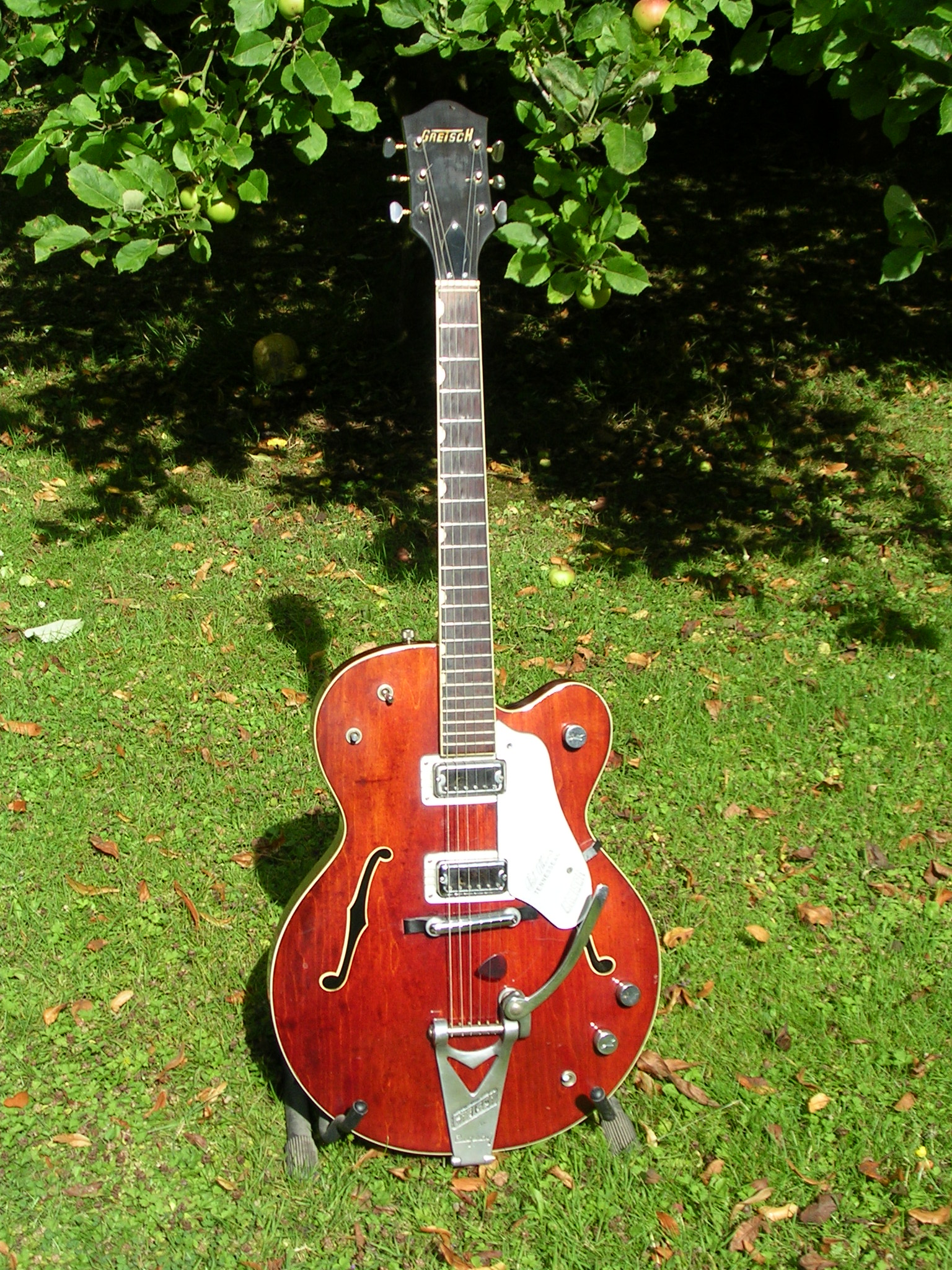
Gretsch 6119 Tennessean Chet Atkins 1964
By Francis pullen
Public Domain, Link
The Ibanez Artcore AFV75
The Artcore series, started at 2002, are Ibanez’s version of great value Hollow Body guitars. This is a very versatile guitar that manages to give great sound, typical of Hollow Bodies with a moderate price.
A few Specs: Scale length of 24 ¾, a 12” fingerboard radius, a linden body with a Nyatoh Neck, 22 Frets and 2 Classic Elite pickups

Ibanez Artcore
By aspromusic
CC BY-SA 3.0, Link
Epiphone Casino
Epiphones are usually perceived as the cost effective sibling of Gibson (Which they are) and often dismissed when it comes to quality and success compared to the bigger brother. The Casino is one exception with an impressive number of artists who used it in studio and on stage. The Casino was first sold in 1961 and has had minor changes to it since. At one point or another all the Beatles (well, except Ringo) played an Epiphone Casino
A few Specs: Scale length of 24 ¾, a 12” fingerboard radius (14” on the original models), optional Bigsby Tremolo and two P-90 single coil pickups
Famous for being played by: George Harrison, John Lennon, Paul McCartney, Keith Richards, The Edge, Joshua Homme, Daniel Kessler, Noel Gallagher, Peter Green and Dave Grohl
Semi Hollow Body
The Semi Hollow Body Guitars are trying to combine the benefits of the Hollo Body Guitars without the drawbacks. They produce a lot less feedback than the Hollow guitar but can still be problematic with high volume and when heavily distorted. These guitars have made their mark in history and have been used by many iconic artists. Semi Hollows can be thought of as Hollo Bodies with a reinforced center or Solid Bodies with hollowed out sections and construction wise there are probably both. The dominating shape is usually symmetrical with a fairly large round body (much like acoustic guitars) but with two symmetrical and round cutouts. Another typical trait are the f-holes (or other shape) giving away the hollowness and reminiscent of classical instruments such as violins and violas. The Semi Hollow Guitars lend their sound well to Jazz and blues musicians but definitely made their way into rock as well.
Examples of Semi Hollow Body Electric Guitars
Gibson ES-335
Gibson tried to combine the qualities of its ES-175 with the practicality of the solid body guitars it was already making. In 1958 the ES-335 was born and was an immediate success. The result gave that deeper, warmer sound of Hollow Bodies but also gained the improved sustain and more resistance to feedbacks. On the one hand it was a compromise for both types of guitars, but what you actually gained was a much more diverse guitar with appeal to a wide range of styles and just looking at the list of musicians who used this guitar will give you a sense of how versatile it is. From old school blues to progressive rock. It was even the chosen guitar for Marty Mcfly (played by Michael J. Fox in Back to the Future) when he practically invented rock’n’roll.
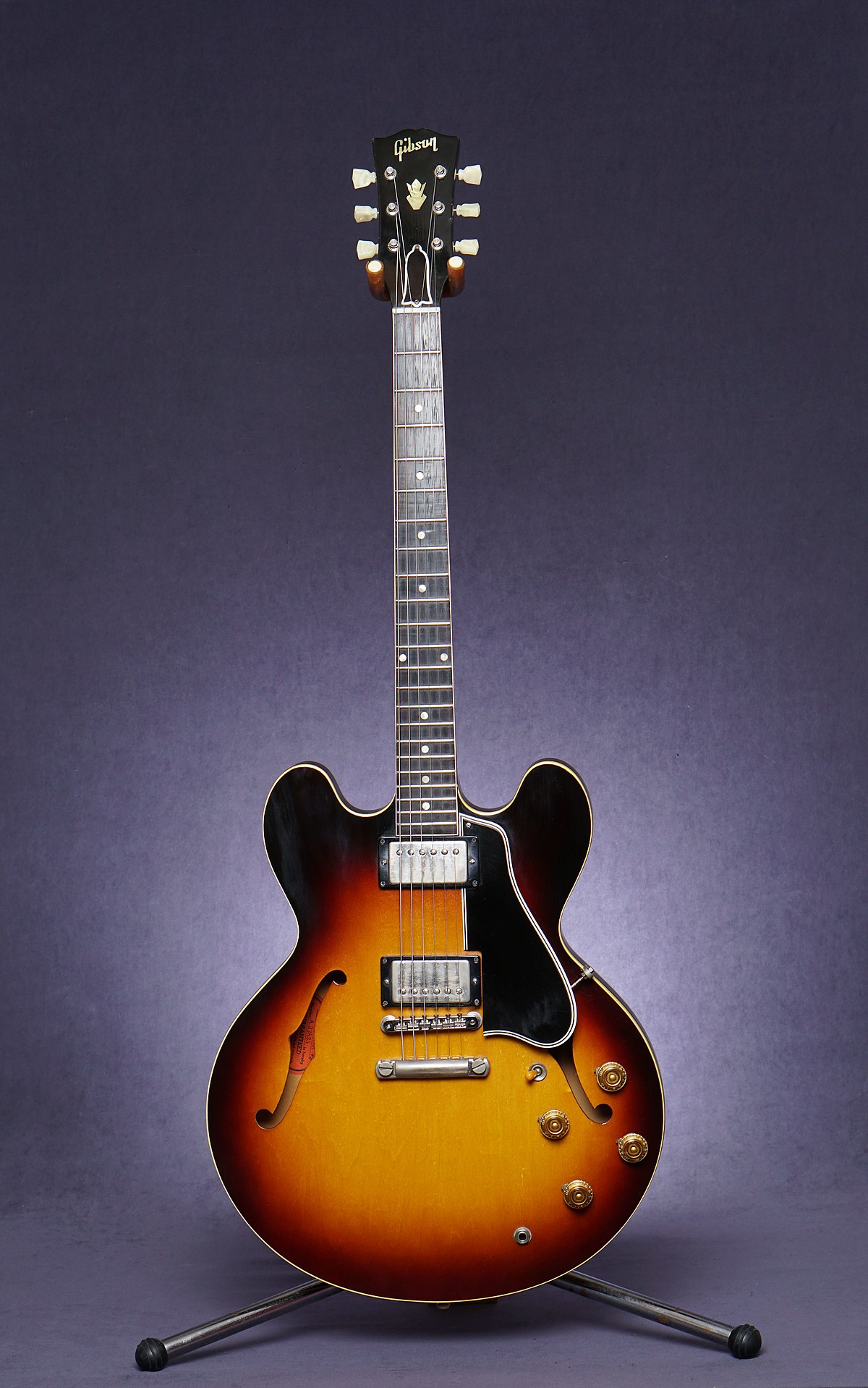
1960 GibsonES-335TD
By Lubbad85
CC BY-SA 4.0, Link
Variations: There have been multiple variations, custom versions and signature model based on the ES-355, best known is probably B.B King’s Lucille.
A few Specs: As most Gibsons it has Scale length of 24 ¾, a 12” fingerboard radius, 22 frets, Mahogany neck and two Burstbucker pickups
Famous for being played by: Trini Lopez (2 Signature Models) John McLaughlin, Chuck Berry, John Lennon, Dave Grohl (Signature model), B.B king, The Cure.
PRS S2 Custom 22 Semi-hollow
This PRS is part of a Solid Body line of guitars and has that little extra depth you get with the hollow chambers and the f-hole without too much sacrifice on the top end and the punchiness.
A few Specs: Scale length of 25”, a 10” fingerboard radius, 22 frets, Mahogany neck and body with flamed maple top and 2 PRS S2 pickups and the PRS Tremolo arm
Famous for being played by: Carlos Santana
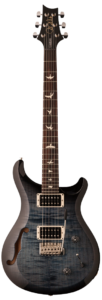
Fender Telecaster 72 Thinline
Everyone knows the Fender Telecaster (and there will be more when we get to Solid Bodies), but the Thinline is a bit more obscure. First introduced in 1968 it was designed to have reduced weight by leaving a center block for stability and sustain and leaving the wings hollow. There have been a few variations of pickups, from the original Tele setup to two wide-range humbuckers, which give a very gentle depth to the normal extra clear of the typical Tele.The newer versions with the humbuckers replacing the single coils have the added value of loosing the typical single coil noise but at the same time the hollowed body is more sensitive to feedback at high volume and when using distortion.
A few Specs: Scale length of 25.5”, a 7 ¼ ” fingerboard radius, 20 frets, a bullet truss rod, 2 Fender “Wide Range” Humbuckers and a Semi-Hollow Ash Body
Famous for being played by: Jonny Lang, the late Curtis Mayfield, Sly Stone, Tab Benoit and Bill Frisell

Rickenbacker 300 Series
The 300 Series first appeared in 1958. Some models don’t seem like a Semi Hollow guitar as there are no sound holes on many of them. The serious has many little variations from slight cosmetic ones to pickup switching and changes in scale length and pickups. They are easily recognizable by their two sharp and slightly irregular cutouts. The Rickenbacker had become famous mostly by the Beatles. John Lennon used a 325 model and George Harrison used a model 360 on the album ‘A hard day’s night’ and again in the movie by the same name. If you want to describe the sound, for lack of better description, I would say it sounds ‘Beatlesy’.
A few Specs: Scale length of 20.75″ to 25”, a 7 ¼ ” fingerboard radius, 21-24 frets
Famous for being played by: Paul Weller, Tom Petty, Pete Touwnsted, John Lennon and George Harrison

Rickenbacker 325C64 (A reissue of the 1964 model 325 played by John Lennon)
By CasinoKat
CC BY-SA 3.0, Link
Solid Body Instruments
Solid Body Electric guitars have no acoustic chambers whatsoever and rely on the magnetic pickups to amplify the strings vibrations and convert them to sounds. This will naturally give a much better bite when it comes to the higher tones. Since the 50’s Solid Body Guitars have dominated the market in sales and with musicians. Solid Bodies offer better sustain then their hollow counterparts and as an added bonus are much more resilient to feedback. This makes them a perfect fit for rock and metal which tend to be high in both general output and distortion. The clean sound of Solid Body guitars also lends itself well to all kind of pedals and effects and will give more predictable results.
For many years the shape and style of the Fenders, Telecaster and even more so Stratocaster, and the Gibson Les Paul and SG, have dominated the electric guitar world and were the subjects of copying and mimicking from reputable companies, small companies, private builders and cheap knockoffs. But aside from all the more conventional guitars which pretty much made variations on the same few models slowly but surely some other styles and shapes evolved.
Examples of Solid Body Electric Guitars
Fender Telecaster
Leo Fender set out to create a guitar that would be cost effective to make, and have the bright clean tone which was then associated with country music. The full solid body with the bolt on neck have since become common but were an innovation in the early 50’s. Originally named ‘Broadcaster’ the name was quickly changed (because of copyrights) to Telecaster and became the longest selling production guitar in history. The simplicity of two single coil pickups, the removable pickguard control plate and the removable neck made servicing and assembling the guitar much easier than before. The single piece narrow neck made manufacturing easier and more economic as well. Aside from the practical aspect of the construction and maintenance the Telecaster soon became a hit with musicians from all types of styles from country and blues to jazz and rock. The bright and clear sound appealed to many players, and lend itself well to all genres. The Solid Body was also a good match to distortion, which was growing in popularity, as it created very little feedback even at high gain.
A few Specs: Scale length of 25. 5″ , a 9.5 ” (originally 7.5”) fingerboard radius, 21 frets, two vintage single coil pickups, Telecaster “Ashtray” bridge with 3 saddles (6 in newer models)
Famous for being played by: Bruce Springsteen, Keith Richards, Jeff Buckley, Prince, George Harrison, Muddy Waters, Roy Buchanan, Danny Gatton, Brad Paisley, Jeff Beck and a long list of many others…
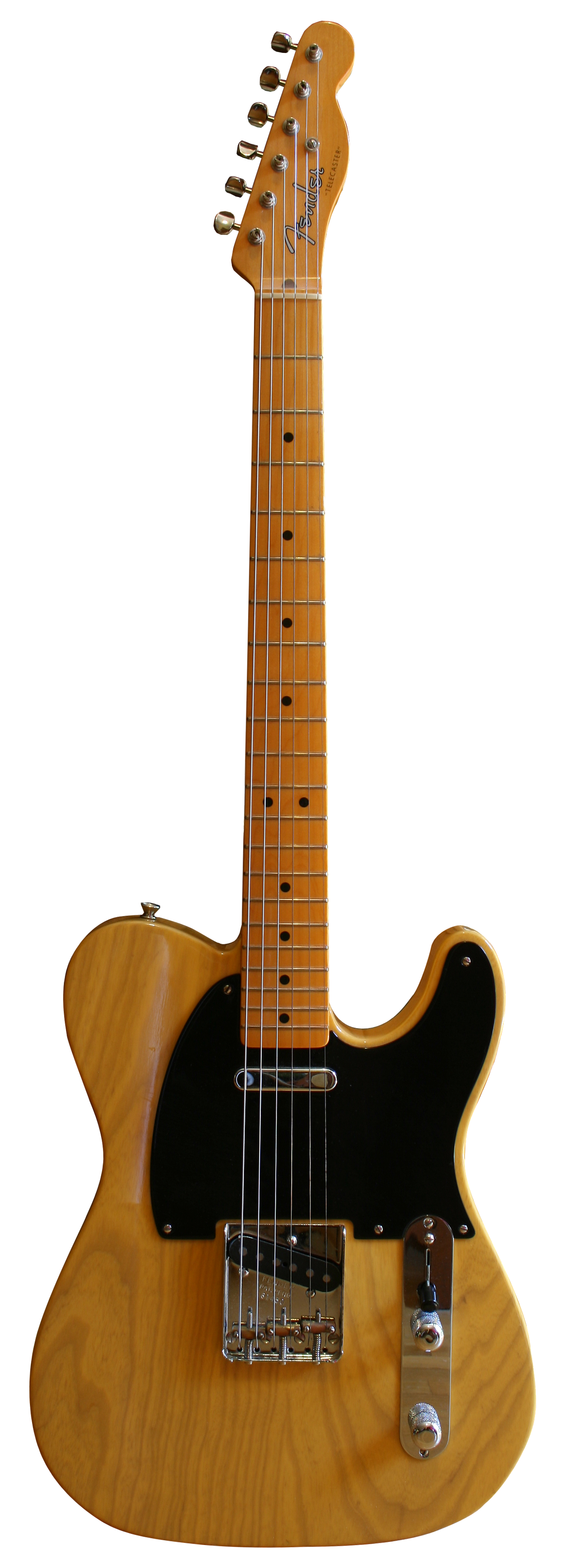
Fender Telecaster 1952
By Massimo Barbieri CC BY-SA 3.0, Link
Fender Stratocaster
The Stratocaster is one of the most popular if not the number one guitar in history. The irregular double cutaway shape is almost synonymous with the term ‘electric guitar’. The shape and sound of the Strat has been copied and replicated by many companies and guitar builders. Arriving to the world at 1954 the Strat followed the Telecaster and was designed to be more and better than it’s sibling. Two cutaways, round edges, three pickups with a 5 way selection switch, and a whammy bar on every model. These specs were unprecedented on a production guitar. Despite the popularity the basic model had very few changes and accept the American Standard Stratocaster that received a slightly wider and flatter neck and improved Tremolo System, the base model has remained pretty much the same.
The Strat sound is bright although not as twangy as the Telecaster. With three pickups you can usually find the sound to fit your need. It works well with blues, rock, funk, metal and anything in between.
A few Specs: Scale length of 25.5″, a 9.5 ” (originally 7.5”) fingerboard radius, 21 frets, three sing single coil pickups, a 5 way switch and spring loaded tremolo system
Famous for being played by: Jimi Hendrix, Eric Clapton, David Gilmour, Jeff Beck, Buddy Holly, Yngwie Malmsteen, Ritchie Blackmore, The Edge, Mark Knopfler, Stevie Ray Vaughan and many others
Gibson Les Paul
If you are not a Fender fan, chances are you are a Les Paul lover (and yes, you can love both) The The Gibson made Les Paul arrived on 1952 with the help of then guitarist Les Paul. It was Gibson’s first production solid Body guitar to rival the Telecaster. The Les Paul used a single cutaway and two single coil pickups but used a set-in neck, mahogany body and neck and a 24.75” scale length. The Les Paul only received the now legendary humbuckers in 1957. Being the only guitar to rival the Stratocaster in prestige it’s hard to think that it was not an instant success when it was introduced. In fact, it was discontinued from 1961 to 1968. Fortunatly for Gibson the Las Paul had a unique sound, with the humbuckers giving a much thicker more powerful tone than the single coiled Fenders and along with great sustain and it became a favorite among a wide range of styles and performers.
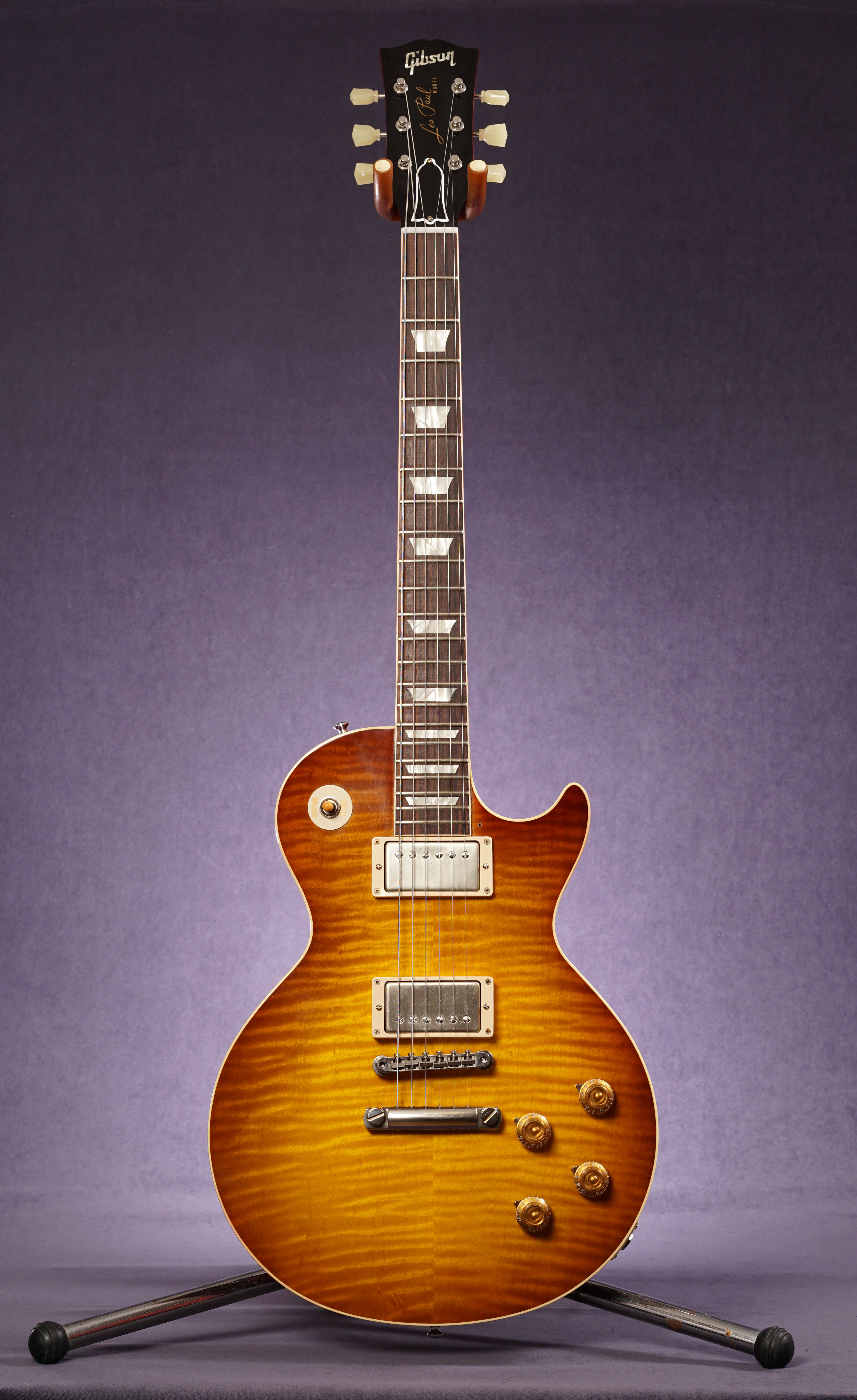
Gibson Les-Paul
By Lubbad85
CC BY-SA 4.0, Link
A few Specs: Scale length of 24.75, 12” fingerboard radius, 2 humbuckers and a mahogany body and neck
Famous for being played by: Jimmy Page, Slash, Paul McCartney, Frank Zappa, Pete Townshend, Zakk Wylde, Gary Moore, Bob Marley, Ace Frehley
Gibson Les Paul
Gibson SG
The Gibson SG was introduced to the world in 1961 when sales of the Les Paul were flailing. In fact it was originally called the Les Paul SG (Solid Guitar). Les Paul himself was not happy with the guitar design (and some other personal reasons) and asked his name to be removed leaving it as the SG. Although the original Les Paul came back and became a more prestigious model, the SG is Gibson’s all-time best seller and has been in production consistently since it was created.
Angus Young With Gibson SG
By Weatherman90
CC BY-SA 3.0, Link
With specs fairly similar to the Les Paul the SG has a slimmer more contoured body with a double cutaway and thinner neck for faster, better access to the higher notes. The SG joins neck joins the body at the 22nd fret whereas the Less Paul at the 16th. If you are a lead guitarist who likes those high notes, it’s a significant difference. Combine with a slightly punchier version of the great deep, thick Gibson sound and you get a great guitar for any occasion. Ad the lower price point and its not a big surprise the SG is a best seller.
A few Specs: Scale length of 24.75, 12” fingerboard radius, 2 (or three) humbuckers and a mahogany body and neck.
Famous for being played by: Angus Young , Tony, Robbie Krieger, Frank Zappa, Derek Trucks, Jerry Garcia, Mike Ness, Mick Taylor, Eddie Vedder
This is where things get interesting
Gibson were actually one of the first to make ‘less conventional’ guitars. After the classic shapes of the Les Paul and the SG the ventured to create the Flying V and the Explorer. Although it took a while for these two to gain popularity, they paved the way to unconventional, and sometimes outrageous, shapes and styles that you might see today in custom shops and shows.
Gibson Explorer & Gibson Flying V
Both of these guitars were born in 1958, probably way ahead of their time, design wise.
Gibson made both in very limited numbers and actually stopped selling them at one point. They were returned in 1976 (the explorer) and 1967 (the Flying V) due to popular demand and have had their following since. The specs were not much different than the SG and give the typical thick Gibson sound. We will have two Burstbuckers and Mahogany body and neck you will get the combination of deep lows, complex mid and gentle highs. Sound wise these guitars can cover a very wide range of music styles but chances are you are not going to bring a Flying V to a jazz session. The design of these two will probably be more fitting to rock or heavier guitar playing.
A few Specs: Scale length of 24.75, 12” fingerboard radius, 22 frets, 2 Bustumbuckers and a Mahogany body and neck
Famous for being played by: The Edge, Allen Collins, Eric Clapton(pre-Strat), James Hetfield (Explorer) The Kinks, Jimi Hendrix, Lenny Kravitz, Albert King, Grace Potter (Flying V)
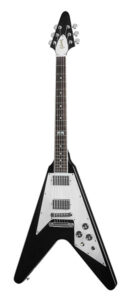

Gibson Explorer
By ZngZng
Public Domain, Link
The ‘Super Strat’
Looking at Ibanez guitars in the early 80’s (without getting into lawsuits and politics), they were known for decent lookalike guitars for a decent price.
In fact, my first electric guitar was a Blazer series Strat looking Ibanez I bought in a little music store in Bergen Norway in 1984. In the mid 80’s Ibanez have shifted from well known designs and have started creating their own version which became known as the ‘Super Strat’. Although there is a ‘family resemblance’ to the Stratocaster these guitars were not copies. The body was reshaped and all the parts were pushed to the extreme. When Eddie Van Halen created his Frankenstrat Guitar it became evident that guitarists need something new. Ibanez designed their new guitars to meet the demand of artists who wanted ‘more’. Steve Vai teamed up with Ibanez to create a guitar tailored to his unique and extreme style. This guitar had specs which would become their JEM series, and also spawn the more affordable RG series. These guitar created a style that became dominant in the late 90’s new metal sound.
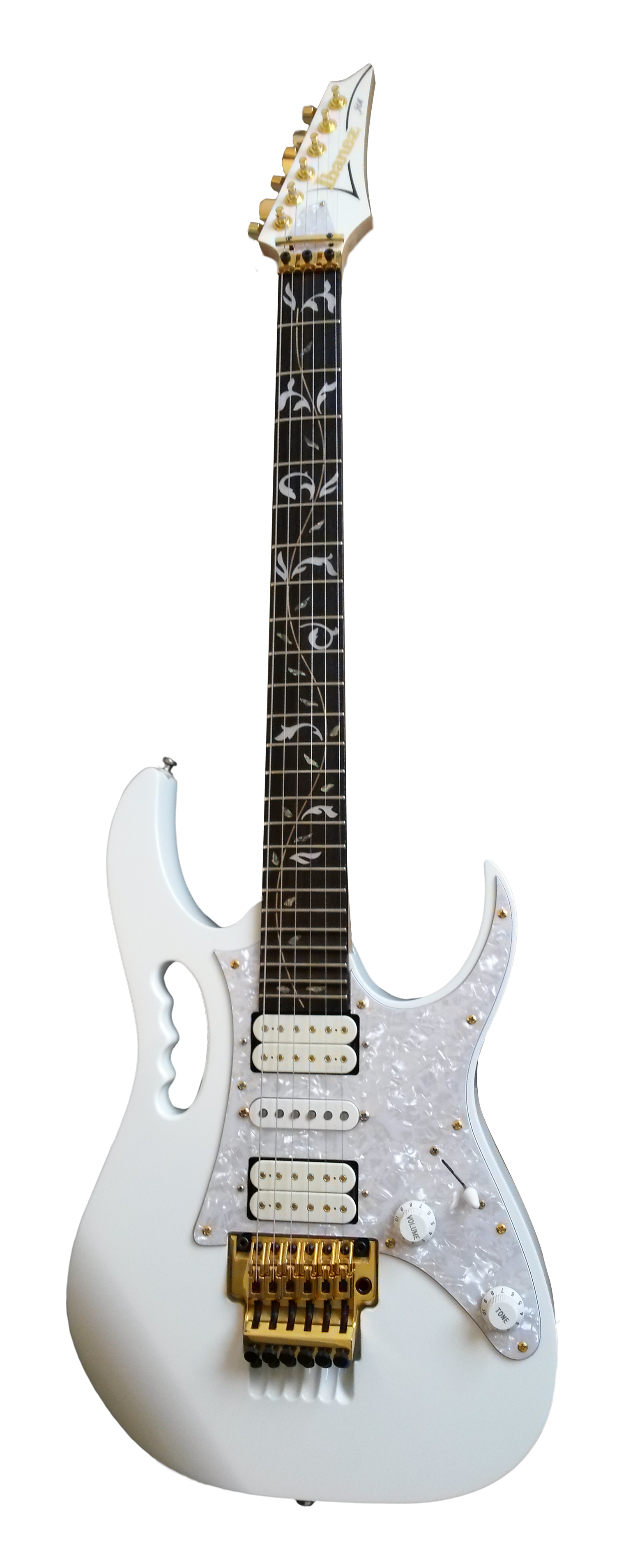
Ibanez JEM
By GreyCat
CC BY-SA 4.0, Link
What about the Pickups?
Pickups are undoubtfully one of the most important (if not the first) to determine the sound of any electric guitar. The exact same guitar fitted with a humbucker will certainly sound much different than with a single coil pickup. Most classic guitars will have their typical set of pickups and give us an expected combination of sound. Once we start mixing and matching, types of wood, guitar styles, scale length and pickups, the results are endless and not always predictable.
Guitar Styles by Genre
There is a tendency to categorize guitars to certain styles and in many cases, you see a correlation between certain artists and guitars. These are generalizations and although certain types of sounds do make sense for certain styles, the beauty of music is that there is. If I play a 60’s Strat there is no guarantee I will sound like Hendrix and on the other hand when Eric Clapton picks up any guitar, he sounds like, well, Eric Clapton. The type of guitar will merely give a slightly different tone or flavor to the artists’ pallet. If you are choosing a Semi Hollow Body to add some tonal warmth to a song or if you prefer the clear-cut sound of a Telecaster, are choices that can vary according to mood or personal taste. Comfort and playability are as very subjective as the way you hold your pick, the pedals you prefer or the type of strap you use.
Guitar Styles by Genre
There is a tendency to categorize guitars to certain styles and in many cases, you see a correlation between certain artists and guitars. These are generalizations and although certain types of sounds do make sense for certain styles, the beauty of music is that there is. If I play a 60’s Strat there is no guarantee I will sound like Hendrix and on the other hand when Eric Clapton picks up any guitar, he sounds like, well, Eric Clapton. The type of guitar will merely give a slightly different tone or flavor to the artists’ pallet. If you are choosing a Semi Hollow Body to add some tonal warmth to a song or if you prefer the clear-cut sound of a Telecaster, are choices that can vary according to mood or personal taste. Comfort and playability are as very subjective as the way you hold your pick, the pedals you prefer or the type of strap you use.
Conclusion
Once electric guitars deviated from the classic Spanish guitar shape many designs and styles developed. While we tend to associate certain shapes and styles with music genres or certain trends, we see that there isn’t always correlation between the shape and the sound. Many artists will have several guitars and use them according to what they see fit, their mood or a whim. A big part of this has to do with the feeling a guitar will evoke when playing and that can be affected by visual shape, sound, a memory or just the way feels in your hand.
When buying a guitar, the shape can be a factor or indicator in your decision but should probably not be the only factor.
If you are planning to build a guitar you are in luck, you can build whatever shape you like with any character, sound or style you wish.
What about the Pickups?
Pickups are undoubtfully one of the most important (if not the first) to determine the sound of any electric guitar. The exact same guitar fitted with a humbucker will certainly sound much different than with a single coil pickup. Most classic guitars will have their typical set of pickups and give us an expected combination of sound. Once we start mixing and matching, types of wood, guitar styles, scale length and pickups, the results are endless and not always predictable.

